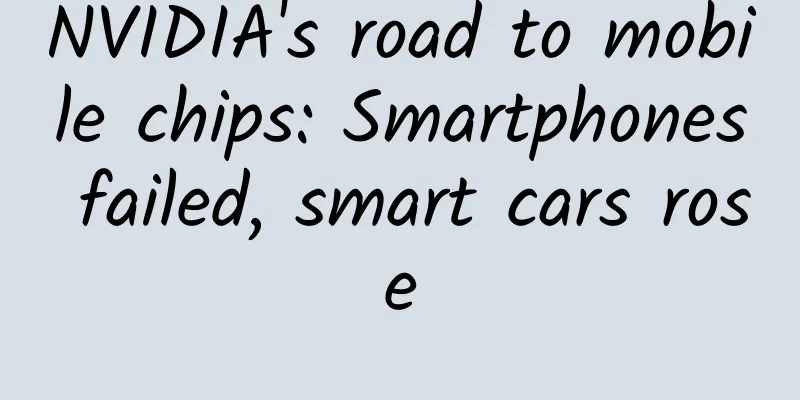NVIDIA's road to mobile chips: Smartphones failed, smart cars rose

|
I believe every computer user is familiar with the name NVIDIA. This world-renowned GPU manufacturer has become the absolute king in the field of image processors. But even with a huge market share, in the past 17 years, NVIDIA's stock price has almost always hovered around $20 (corresponding to a market value of about $10 billion), and its Tegra series processors have not been very popular in the field of smartphones. But since 2015, NVIDIA's stock price has soared, not only sweeping away the haze in the mobile processor market, but also breaking through $100 (corresponding to a market value of about $60 billion), reaching an unprecedented new height. ↑ Changes in NVIDIA's stock price since its listing via Bloomberg In the past two years, NVIDIA has rapidly expanded into the automotive and deep learning fields. Based on the Tegra processor, it has launched the DRIVE PX and DRIVE PX2 autonomous vehicle computing platforms, and has begun to cooperate with Tesla, Audi, Bosch and other automakers to develop driverless technology. At CES 2017, it launched the NVIDIA BB8 driverless prototype car equipped with DRIVE PX2. This time, in the trend of autonomous driving and smart cars, NVIDIA may become the new king. ↑ NVIDIA's driverless test car at CES 2017 1. GPU king fails in the smartphone era NVIDIA, which has been deeply involved in the GPU field, launched the mobile processor Tegra based on ARM and Geforce in 2008. Later, due to the huge advantages of this processor series in image processing, it quickly occupied the game console and tablet market with high image processing requirements, and continued to update and upgrade in the following years. However, in the field of smartphones, the Tegra series has been beaten by Qualcomm and Samsung, and even Huawei has come from behind. Since Tegra 4, NVIDIA has almost disappeared in the smartphone field. Even the Xiaomi 3 mobile phone, which was the first to launch the T4 processor, is still complained by users. NVIDIA, the GPU king, got up early in the smartphone market but arrived late. This failure was accidental, but more inevitable. ↑ The Tegra series processors that were once highly anticipated 1. Baseband - the core of mobile phone CPU Baseband, a general term for modulation and demodulation technology, is the key bridge responsible for the reception and conversion of mobile phones and external signals. All communication technologies such as calls, Internet access, and standby cannot bypass it. We generally think that the performance of mobile phone CPUs is reflected in their processing speed and power consumption. In fact, in the era of smart phones, there is another most basic and critical demand - mobile phone signal quality. This communication function determined by baseband performance directly determines the call quality and Internet access speed of mobile phones. In the field of baseband technology, NVIDIA is almost a blank slate. Not only NVIDIA, but also giants in the analog communication era such as Texas Instruments and Motorola have no achievements in digital communication technology (3G, 4G). The patents in this field are almost all monopolized by Qualcomm. Qualcomm also relies on its baseband technology to launch the Snapdragon series of integrated mobile processing chips, and gradually become the mainstream in this field. In the case of mobile phone processors using ARM architecture, the performance differences among different manufacturers are not particularly large, but Qualcomm can still provide stable and reliable integrated basebands, and its cost has an absolute advantage. After all, even if NVIDIA processors are more powerful, they still use Qualcomm's baseband chips, which increases the difficulty and cost of development. At this point, not only NVIDIA, but most manufacturers are bound to decline, unless you can develop your own baseband patent technology, such as Huawei's Kirin series, a rising star. ↑ Qualcomm Snapdragon and Huawei Kirin processors with integrated baseband 2. Positioning deviation + T4 difficult to produce NVIDIA started as a GPU and switched to mobile processing chips. It will definitely not give up this advantage. Therefore, the Tegra processor integrates powerful image processing functions and focuses on the tablet and game console markets. The success of T1 in these two fields also proves NVIDIA's strength. Therefore, T2 still focuses on this, but at this time, 3G and 4G technologies began to ferment, and Qualcomm launched a strong attack. In this era, T2 can also have a certain market in the mobile phone field with its image processing performance, but NVIDIA has missed the opportunity to integrate the baseband at this time, and T3 is almost completely behind. Subsequently, the difficult production and high power consumption of T4 also doomed NVIDIA to be doomed in the mobile phone field. 2. Smart Cars - The Road to the New King The failure in the smartphone market did not make Huang Renxun compromise. At the NVIDIA new product launch conference in 2015, the tegra X1 processor was released, but this time Huang only briefly introduced this new product, and then threw a bombshell - DRIVE PX, a new smart car processing platform built based on Tegra X1. NVIDIA officially announced its aggressive entry into the automotive field, and Audi, Tesla and other car companies also began to cooperate with it. Subsequently, NVIDIA's stock price began to soar. So was this success accidental or inevitable? ↑ Roborace driverless racing car equipped with DRIVE PX 2 1. The difference between GPU and CPU Both CPU and GPU are indispensable key processors in modern computer technology. CPU is good at complex logical operations and general data operations, and was invented to solve complex calculations and control; GPU is good at large data volumes and simple logical repeated calculations, and was invented to solve image pixel processing. The different design goals make the structures of the two also have huge differences, as shown in the following figure: ↑ Comparison of CPU and GPU structures The CPU has powerful computing units and huge cache areas. When performing complex calculations and controls, the computing units can ensure the efficiency of the calculations, and the cache area can provide sufficient data loading areas. Even complex calculations and terminal logic can ensure speed and accuracy. Therefore, the CPU is better at serial operations and logic control. The GPU has many dense computing units and a small number of cache areas. Each thread is equipped with a cache area and a control unit, and the computing unit only needs to process simple logic, which also allows each thread to work concurrently at the same time. Therefore, the GPU is suitable for large-scale, simple logic parallel operations. 2. GPU acceleration algorithm The core of image processing is to process pixels with simple information but huge numbers. This is the stage for the birth of GPU. Using GPU to process images and rendering can greatly improve efficiency. On this basis, NVIDIA proposed a method of GPU accelerated computing, which uses CPU and GPU to process computing tasks at the same time, puts the intensive computing of the program on the GPU, and other logic is still completed on the CPU. This combination allows the GPU to play a role in more application scenarios. ↑ NVIDIA GPU acceleration algorithm diagram For example, in the field of machine learning, the powerful parallel computing power provided by the GPU is used to process massive amounts of learning data, and the CPU is used to complete other logic. The Tegra series processors can perfectly support this computing method, which makes NVIDIA the first choice for many machine learning systems. According to Professor Ian Lane of Carnegie Mellon University: "With the help of GPU, the transcription speed of pre-recorded speech or multimedia content can be greatly improved. Compared with CPU software, the speed of our recognition tasks can be increased by 33 times." ↑ Benchmark test results of NVIDIA k40 processor for machine learning applications 3. Tegra's new stage - autonomous driving Image processing and machine learning have become indispensable technologies for autonomous driving. Environmental perception and target recognition in autonomous driving require the participation of image processing; and with the help of machine learning algorithms, the efficiency and accuracy of target recognition can be effectively improved, which also brings a new stage for NVIDIA Tegra processors. ↑ NVIDIA autonomous driving system diagram NVIDIA uses two Tegra processors on the DRIVE PX2 platform, and includes a new generation of powerful Pascal architecture GPU, which can simultaneously receive and process signals from 12 high-definition cameras, and can fuse data from multiple cameras and lidar, radar and ultrasonic sensors, which allows the algorithm to perceive the environment around the car in 360 degrees, thereby generating stable images, including static and dynamic targets. The application of DNN (deep neural network) significantly improves the accuracy of fused sensor data results in detection and target classification. This all-round autonomous driving processing platform almost surpasses the performance of all current automotive processors, and has become the first choice for many manufacturers to develop autonomous driving technology. ↑ NVIDIA releases DRIVE PX 2 platform In addition, the performance and development experience of the Tegra series on mobile platforms can support navigation, instrumentation and in-car entertainment applications. Tesla used the Tegra 3 processor on the Model S to support the large central touch screen. It is said that because Tesla founder Elon Musk and Huang Renxun have a good personal relationship, NVIDIA entered the automotive field early and accumulated a lot of experience. In the emerging field of autonomous driving, there is a blank in industry standards. NVIDIA entered this field first and has already gained a lot of experience and market advantages. ↑ NVIDIA's partners in the automotive field III. The road to success is not easy Although NVIDIA's prospects seem bright now, its road to becoming a smart car giant is not smooth. 1. Barriers in the automotive electronics industry Compared with the consumer electronics field, the automotive industry has its own particularity and demanding requirements. Many requirements such as service life, extreme environment resistance, electromagnetic compatibility, functional safety, etc. have posed great challenges to the hardware of automotive electronics, and can even be said to be a technical barrier in the automotive electronics industry. Especially in the field of highly integrated processors, the 20nm commonly seen in consumer electronics is almost rare in automotive electronics. Instead, 16-bit and 32-bit processors from Renesas and Freescale are popular. The first thing to ensure in a car is safety. Only after sufficient verification can it be used on a large scale. This is also the reason why traditional car manufacturers have always been conservative. 2. Competitors' pursuit Last year, a major event happened in the automotive electronics field. Qualcomm acquired the automotive chip giant NXP. The acquisition price set a record for acquisitions in the semiconductor industry. The year before, NXP also acquired Freescale and became the largest manufacturer of automotive chips. Qualcomm's intention in carrying out this acquisition plan is obvious. With the development of autonomous driving and car networking, the automotive electronics industry has become the next hot spot. With Qualcomm's strength and ambition, I believe the competition in this field will become more intense, and NVIDIA will face the challenge of its old rival again. ↑ Qualcomm acquires NXP for $40 billion . IV. Summary NVIDIA made its fortune in the development of personal computers and became a giant in the field of image processing by relying on GPU. In 2008, it switched to mobile platforms and launched the Tegra series of processors. However, its excellent processing performance could not withstand Qualcomm's monopoly on baseband technology in the 3G and 4G eras, which led to its failure in the field of smartphones. However, the inherent advantages of GPU in large-scale parallel computing and the founder Huang Renxun's desperate bet have given NVIDIA an advantage in the fields of autonomous driving technology and machine learning in recent years: Tesla integrated Tegra 3, released the DRIVE PX series of autonomous driving platforms, and cooperated deeply with major automobile manufacturers. Because of these layouts, NVIDIA became the first semiconductor company that can provide super car processors, and its advantages in image processing and machine learning are also extremely suitable for the new battlefield of autonomous driving. At present, autonomous driving technology has become a new outlet, and many other emerging players have gradually participated in it. Various high-tech technologies in the fields of Internet, semiconductors, and computers have greatly promoted the development of this industry. The market is also changing rapidly. Who will become the final king? As a winner of Toutiao's Qingyun Plan and Baijiahao's Bai+ Plan, the 2019 Baidu Digital Author of the Year, the Baijiahao's Most Popular Author in the Technology Field, the 2019 Sogou Technology and Culture Author, and the 2021 Baijiahao Quarterly Influential Creator, he has won many awards, including the 2013 Sohu Best Industry Media Person, the 2015 China New Media Entrepreneurship Competition Beijing Third Place, the 2015 Guangmang Experience Award, the 2015 China New Media Entrepreneurship Competition Finals Third Place, and the 2018 Baidu Dynamic Annual Powerful Celebrity. |
<<: Full of black technology: Analysis of UCloud's new generation VPC features
>>: What exactly is AirGig, the black technology that uses wires to transmit network signals?
Recommend
ALS patient tweets: Hello, world!
Recently, domestic and foreign media suddenly bro...
How can a startup company promote itself without any funds?
Startup companies are generally in a state of hav...
Teach you step by step how to promote information flow videos!
Currently, the trend of online video advertising ...
Visual Studio 2015 will be released on July 20
[[138348]] Microsoft has announced that the offic...
[Photo] iPhone 7/7 Plus performance review: crushing Android flagships
[[173106]] In this evaluation, AnandTech still us...
Light-sensing aesthetics, discover more beauty, vivo X23 mobile phone is more than just a little bit better
On September 6, 2018, vivo released the new gener...
Using design to increase conversion rate by 31%! How did Alibaba’s experts do it?
When it comes to innovation, I wonder if you have...
12 tips to thoroughly explain Douyin operation and promotion
In this article, the author will start with the r...
MIR DATABANK: Review of China's industrial robot market in the first three quarters of 2020 and annual forecast
According to MIR DATABANK data, the year-on-year g...
If you write the title of your promotional notes on Xiaohongshu like this, your exposure rate will soar!
The shift in group consumption habits from "...
Why does influencer marketing need the support of paid advertising?
In recent years, influencer marketing has grown f...
What is “native advertising”? What is the development trend?
When we search with the keyword " native adv...
Jaguar Land Rover to hire 5,000 new people to develop autonomous and electric car technologies
LONDON (Reuters) - Britain's largest carmaker...
Apple can beat the FBI, but it may not be able to beat European countries
Bloomberg wrote today that although Apple’s main ...
WeChat prohibits sharing of check-ins? There are also these 7 ways to attract new customers!
The "Announcement on the Handling of Inducem...









